Common Misconceptions about Hierarchical Generative Models (Part 1 of 3)
By Richard D. Lange ca. January 2019
Archival note: this is a post recovered from Richard's old grad-school blog "Box and Arrow Brain." References to 'recent' things are relative to 2019, references to 'the lab' mean the Haefner Lab at UR, and information may generally be outdated.
It's generally understood that the brain processes the visual world hierarchically, starting with low-level features like patches of color, boundaries, and textures, then proceeding to a representation of whole scenes consisting of objects, people, and their relations. We also have reason to believe that the brain has learned a probabilistic generative model of the world where data come in through the senses analogously to raw pixels from a camera, and percepts correspond to structures in the world that the brain infers as the causes of the data.
Consider how images of random trees might be generated. First, choose a species, say a willow. Next, generate its parts: trunk, branches, leaves, etc. Keep breaking parts down by generating their sub-parts, like how a twig contains leaves and a leaf contains a stem and veins. Finally, "render" each sub-part into a small patch of the image. This process is a hierarchical generative model of the tree's image -- we start with an abstract high-level idea of an object, then hierarchically generate more and more specific parts. Inverting this generative model (i.e. doing inference) means working in the reverse direction: starting with pixels, detecting sub-parts, aggregating to parts, and ultimately recognizing objects and scenes.
Hierarchical generative models are important both for neuroscience and for machine learning (ML) and AI. Yet, we lack general, effective methods to fit them to data, and our understanding of the brain's internal model is correspondingly limited. This may be due, in part, to a few intuitions that have been muddled in the field. At the very least, they've been muddled in my own mind until recently, so I wanted to write a series of posts to share some recent insights. What follows is a series of intuitions I've held myself or heard from others, which are, in some big or small way, not quite right.
In total, I have 7 intuitions to be broken down into 3 posts. Stay tuned for the rest!
Intuition 1: the brain approximates the true model of the world
What does it mean for the brain to learn an "internal model" of the world? The first (naïve) definition might be this: entities, actions, and relations that exist in the world are somehow represented by states of the brain. When looking at an image of a willow tree and its constituent parts, the brain encodes a description of them -- sub-patterns of neural activity corresponding to "trunk," "leaves," "rustling," and the entire tree itself.
According to the naïve definition of an internal model, the state of the world is reflected by states of the brain. I like to visualize this as a landscape reflected in water -- a near-copy of the world flipped upside down and juxtaposed with it, with only a thin barrier between them. The world (W) literally reflected in the model (M).
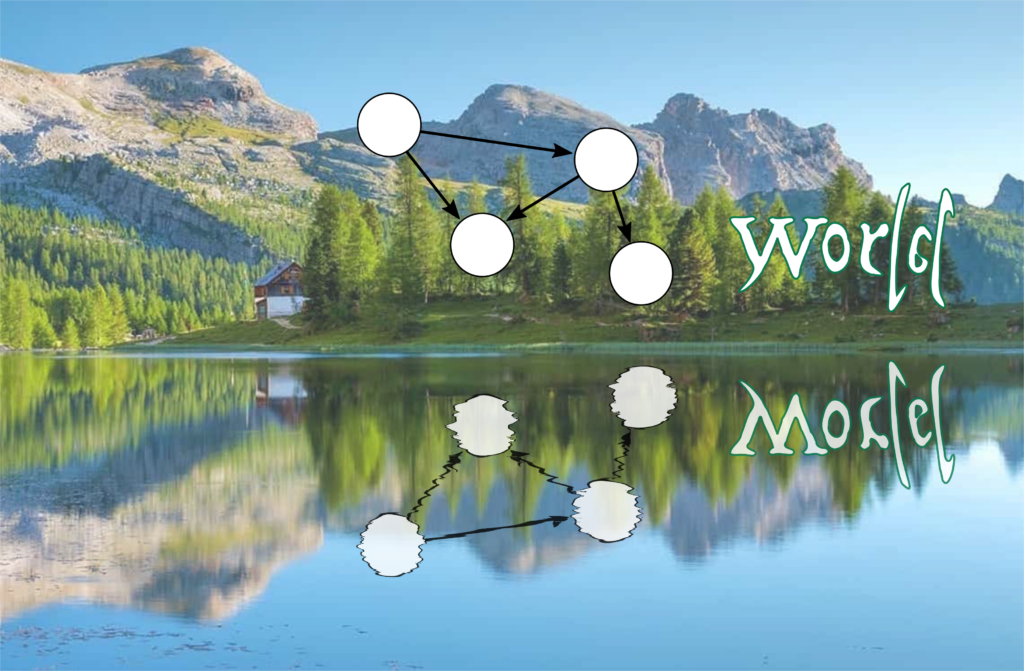
This captures the intuition that the hierarchical structure in the world is directly inverted by perceptual processes in the brain.
Of course, I call this the naïve view for a reason. The brain does not mirror the world as it really is -- how could it[1]? Instead, the brain must have learned its own set of variables. For instance, we often imagine V1 as having learned a model for oriented edges in a scene. And while research has proven that detecting edges and other such low-level image features is an important first step towards scene understanding, I'm skeptical of any argument that those oriented-edge features exist "in the world." At best, they exist "in the image," but the image is a property of the observer, not the environment being perceived! The reflection metaphor deserves an update:
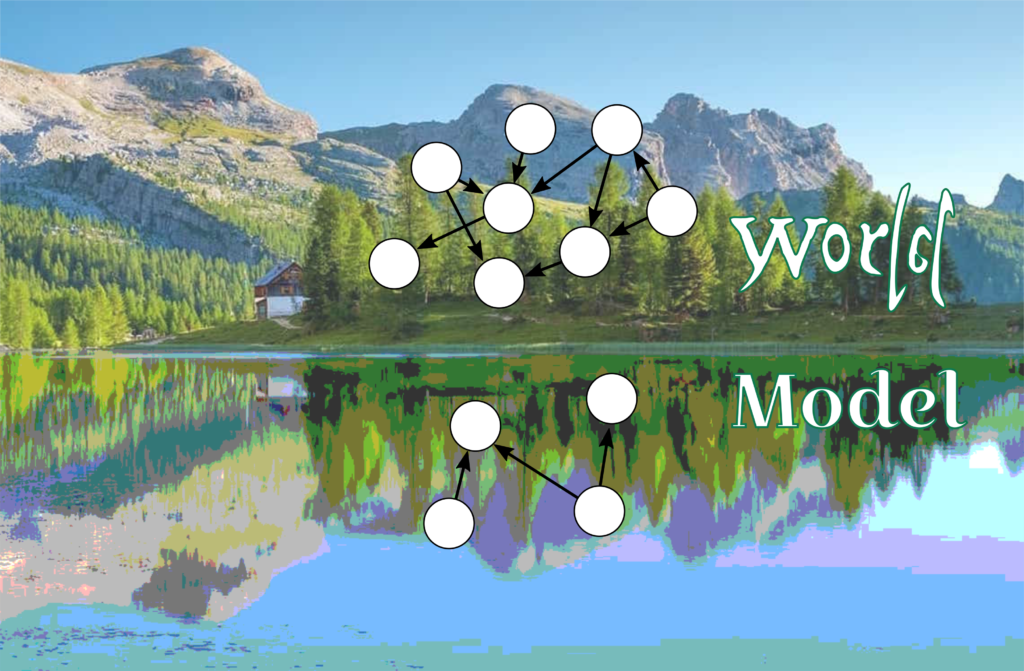
By this I mean more than the old adage that "all models are wrong." Allow me to explain further...
It's common to see hierarchical descriptions of the world (as my willow tree example above) side by side with hierarchical descriptions of sensory processing in the brain. But even if the world is truly hierarchical and the brain processes it hierarchically, that does not imply that the brain "inverts" the world model at every stage! The world is hierarchical in the sense that objects contain parts which contain sub-parts, but the object-recognition processes in the brain are often thought to proceed from edges to textures to shapes back to objects. Even if the brain arrives at a fairly accurate representation of objects in the end, it takes its own route to get there. Image textures are not object parts.
It's also worth noting that in statistics there is typically an implicit assumption that the data were generated from an instance of the model class being fit. It's rarely stated that data are generated from the process W but fit using the the model family M[1]. This has important consequences that break some of the fundamental rules of probability like Bayes' rule and the chain rule. I'll explain more in the next post.
Intuition 2: hierarchical models are basically just more complicated priors
Setting questions about the "true"model of the world aside for a moment, what else are hierarchical models good for? From a purely statistical standpoint, hierarchical models allow us to fit more complex data distributions. Understanding this requires defining the marginal likelihood of a model.
The marginal likelihood or model evidence is a probability
distribution over the input space. Using the tree example above, it
would be a distribution over all possible images of trees that might be
generated by our tree-generating procedure. Recall that our procedure
for generating trees involved first selecting a species, then generating
the trunk, then limbs, then twigs, then leaves, etc. The marginal
likelihood is the probability of getting a given image, summed over all
possible runs of this procedure weighted by how likely each one
is[2]:
...which is, of course, the procedure for marginalizing over other variables in the model, hence the name.
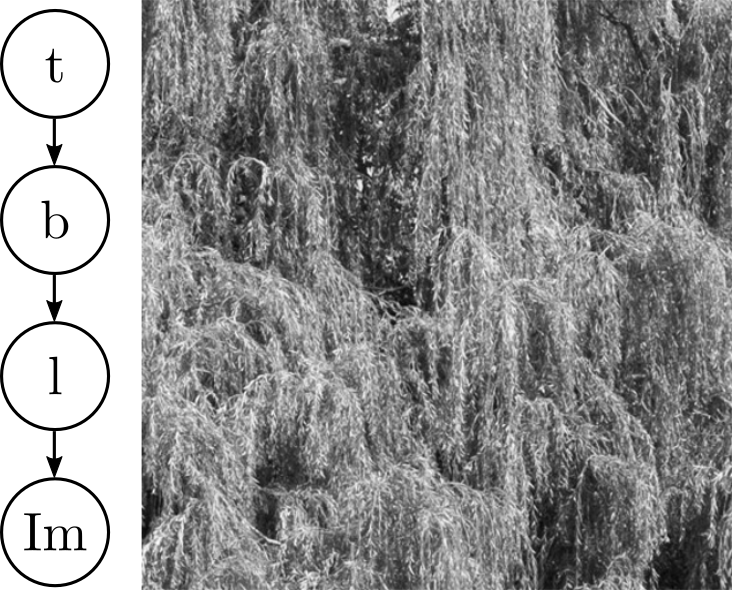
(Notice that I dropped the 'species' variable since 4 layers of hierarchy is plenty for now). We can imagine what would happen if we removed the trunk and branch variables, generating an image by placing leaves anywhere and everywhere at random[3]:
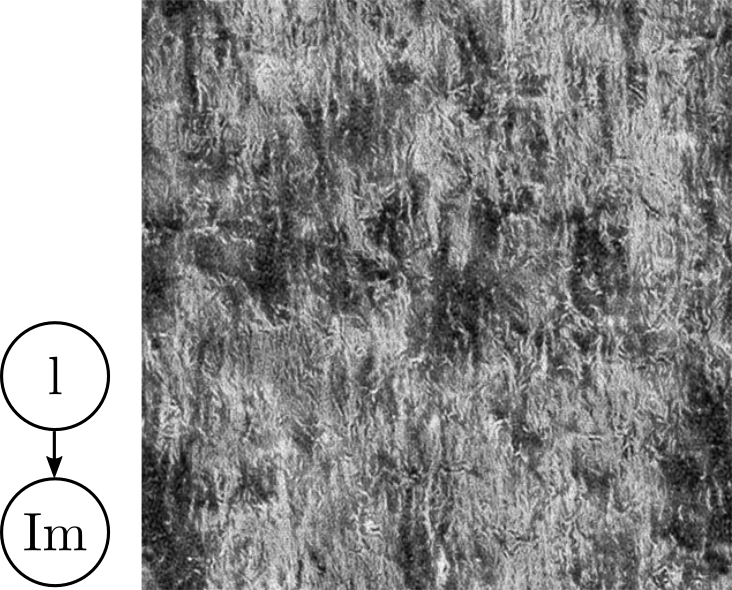
But what if we knew enough about how leaf positions are distributed without writing the full model of tree trunks and branches? If our goal is to generate realistic tree-leaf images (because why wouldn't it be), we could in principle get away with directly modeling the dependencies between leaves:
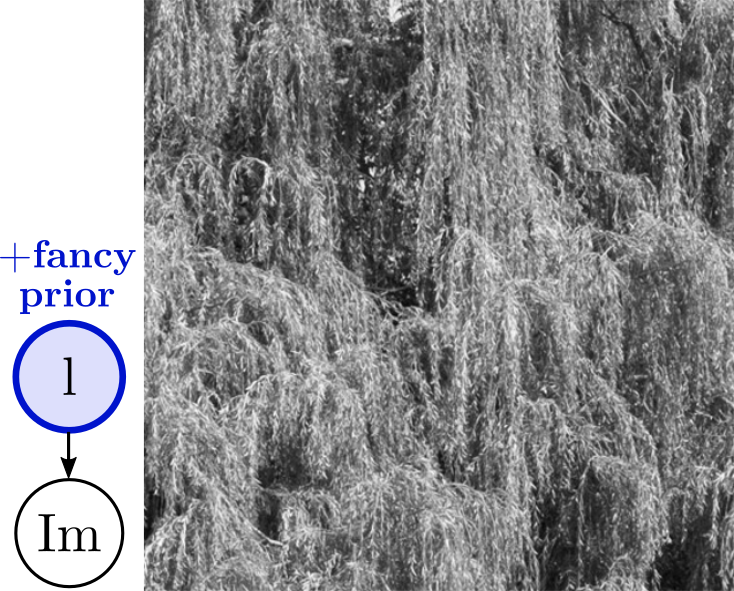
Another way to say this is that, from the perspective of the marginal
likelihood over images, higher-level variables simply serve to induce a
fancy prior on the lower-level variables. Mathematically, we can write
So that the marginal likelihood is simply
This means that [purely from a marginal likelihood standpoint, a hierarchical model is nothing but a fancy prior[4]. So why should we prefer truly hierarchical models to, say, super flexible ("fancy") families of priors? (I'm looking at you, normalizing flows). Here are a few reasons:
- Representation matters. Explicitly representing higher-level variables is almost certainly going to be useful.
- Despite what I wrote in intuition 1, using a hierarchical model to represent a hierarchical world is a good idea. (Ok, so this is just another way of saying that representation matters)
- Inductive biases. There may be many ways to construct arbitrarily flexible priors, but not all of them will be equally effective. Hierarchical models for perception may generalize better from limited data.
- Computational tractability. Most sampling and message-passing algorithms for inference become simple when dependencies between local variables are simple. For example, it would be relatively easy to write an algorithm that actually generates branches and attaches leaves to them. This is an example of a simple dependency. Imagine the mess of code it would take to generate each leaf individually conditioned on where the other leaves are!
In the next post(s), I'll describe how complex priors do not necessarily imply complex posteriors (and vice versa), how model mismatch breaks basic assumptions of probability, and more!
Footnotes
- This is not a point about approximate inference. For instance, we might want to fit model M to data generated by W, but even M could be intractable. We would therefore resort to some approximation Q that gets close to M but is tractable. Now we have to juggle three distinct ideas: the true data-generating process (W), our best approximation to it in a model (M), and the inferences we actually draw (Q).
- I'm simplifying here by assuming that the image is generated
directly from the set of leaves of the tree. Perhaps
- I'm again committing the fallacy here that I warned about inintuition 1: I'm being imprecise about the difference between features of the image and features of objects. Here it's a matter of convenience -- I don't actually have a 3D generative model of trees to render examples from.
- To add a comment about brains, this means that from the perspective of V1, a complicated statistical prior over natural images could in principle be feed-forward. If cortico-cortical feedback is to be understood as priors, it must be because separating the representation of high- and low-level things is useful, and/or because the brain's model and inference algorithm are "locally simple" as described above.
References
- Feldman, J. (2016). What Are the "True" Statistics of the Environment? Cognitive Science, 1--33. http://doi.org/10.1111/cogs.12444
- Zhao, S., Song, J., & Ermon, S. (2016). Learning Hierarchical Features from Generative Models. https://arxiv.org/abs/1702.08396
- Rezende, D. J., & Mohamed, S. (2016). Variational Inference with Normalizing Flows. https://arxiv.org/pdf/1505.05770.pdf